For a little more than a year Kawasaki and Suzuki have had their toes in the water of their unique, share-some-love model-exchange arrangement. In a nutshell, both brands trade selected smaller race and play models so their dealers have chock-full lines. Kawasaki's KX60, KX65, KX100 and KLX110 and Suzuki's JR50, DR-Z125, DR-Z400 and DR-Z400S wear both brands.This is no friendship deal. Neither party would be cooperating if the alliance didn't make business sense for both. Despite the agreement to trade and all the pasted-on smiles, bows and handshakes, Kawasaki and Suzuki remain totally separate companies maintaining a love/hate relationship in place of their historic just-plain-hate connection. After all, isn't all fair in love, war and business?In spite of the potential advantages and possible and real friction in the arrangement, both companies waded in deeper to the next level of cooperation after discovering they were each working on a 250cc four-stroke motocrosser. With the KX-F and RM-Z, the exchange of ideas began on the drawing board. In simplest terms, Suzuki engineers CAD/CAM'd the engine using much of what they already knew from developing the GSX-R1000 sportbike. Remember, each cylinder of a four-cylinder liter bike is 250cc. A quick look at the perimeter-steel design reveals that Kawasaki's people penned the chassis, and they will spit out the entire machine--in green or yellow livery--from their production line.This little KX-F/RM-Z is far from the first new-age, F-1-inspired four-stroke, so its creators have had the successes and failures of the competition to learn from. Before the bike was even displayed in public, the buzz was out that the engine runs very strong, and hidden inside are some interesting uses of existing technology. It is hard to imagine a machine eclipsing the amazing Yamaha YZ250F by a significant margin, but we felt the same way about the YZ426F until the Honda CRF450R made its debut. Yamaha introduced its radical five-valve technology, and Honda proved its innovation with its Unicam design and separate oil for the engine and transmission. At first glance, the KX-F/RM-Z engine appears to have a contemporary yet relatively normal pedigree but with ample proof of sound engineering. First, the crankshaft is mounted very low in the cases to keep the overall center of gravity close to the ground. That crank placement has the drawback of friction and pumping losses as the crank spins in oil, but the co-op engine has the crankshaft semi-separated from the gear case/oil reservoir. The idea isn't new, but previously it was limited to European machinery. They--primarily Husqvarna and Husaberg--used a reed valve to evacuate oil from the crank area; this engine has a chamber at the bottom/rear of the crankshaft that looks like the outlet to a water pump. The edge of the chamber almost acts like a scraper, cleaning the oil off the crank wheels. At the rear of the small chamber the oil pump and a filter are mounted right in the wall between the crankshaft compartment and the gear case. In other lubrication trickiness, the cylinder/head bolt cavities double as oil passages to transport the fluid from the bottom end to and from the camshafts and valve train. In addition, high-pressure oil lubricates the crank and connecting-rod bearings, and an additional pressurized spray of oil is directed at the underside of the piston--a concept Suzuki explored with its early (from 1986 until it went liquid-cooled) air/oil-cooled GSX-R 750cc and 1100cc sportbike engines.More cleverness shows up in the venting of crankcase pressure. The powerplant uses a reed valve to keep the pressure moving in one direction. The kickstart shaft and idler gear double as a centrifugal oil separator, so the motor doesn't require a space-intensive labyrinth to separate oil from the vented pressure.OK, enough with the class tour and the political intrigue. The real question is not whether you need a green or yellow machine, but whether you will want either color rather than the YZ250F or the CRF250R. In other words, does the bike work?Especially for regular two-stroke pilots, the first consideration for a four-stroke is starting. Nothing makes life a misery like a bike that won't start quickly and easily. For the most part, this bike starts readily. The starter kicks effortlessly, and the bike generally fires immediately. One rider got on a bike that had been sitting but was hot. It took a flurry of kicks, and then he tweaked up the idle a hair. After that the bike started with a simple prod of the lever. Remember, with four-strokes, it is always easier to restart if you kill the engine with the kill button rather than stalling it with the clutch.Once the engine is fired, the feeling is as different from the blue small-bore four-stroke as the Honda CRF450R is from the Yamaha YZ450F. The power is smoother with less hit in the mid, but the engine is very healthy in that midrange. It would pull third out of turns when we'd swear it was going to fall flat. Then when we revved the KX-F/RM-Z, it pulled like crazy and never seemed to fall totally flat. This little baby is definitely strong. The clutch is the same diameter as the KX125's but was able to withstand the uphill turn exits Cahuilla Creek is famous for. We never felt the need to adjust it. Shifting is also a pleasant experience, with light, crisp action at the lever and no missed shifts. Neither Cahuilla Creek nor Glen Helen's REM track have many rhythm sections or even a series of jumps that let you judge the response for stadium whoops and such. Nevertheless, the bike seems to respond cleanly without any cranky hiccups or hesitation. It felt as if the engine fell off harder at low rpm than the YZ250F, but remember, we weren't able to get the bikes together for a head-to-head comparison.As we expected, the KX-F and RM-Z feel very Kawasaki-like on the track. The bike is slim and easy to change riding positions on. There are no annoying barbs or catches to snag the rider's boots or gear. The Kawasaki family feel extends to overall sizing that is on the compact side--much like the KX125. The upside is the bike feels light, quick and maneuverable with fast and easy steering. It dives into turns willingly, especially into tight turns with small ruts or berms. Getting on the gas a little earlier than you would on a two-stroke swings the rear around nicely. One of the goals for the motor was reduced engine-braking into corners, which the engineers accomplished with the ignition map. When the bike is shifted into gear, the idle is held slightly higher than when the engine is in neutral--a clever and simple solution to a trait that longtime two-stroke riders find handicapping.One of the historic strengths of the Kawasaki perimeter frame is a solid feel when accelerating and hitting obstacles. The KX-F/RM-Z shares those fine traits. We tested at the high-speed, decomposed granite loam track of Cahuilla Creek. The track had some rough straights and uphills, but they didn't bother the bike. Some of the downhill braking bumps were pretty deep and the bike was a bit busy there; we bottomed the fork some.We didn't test anywhere that would really challenge the bottoming resistance, but it seemed reasonable. At Cahuilla most riders opted for stiffer compression settings for the downhill braking bumps.There is no question this cooperative effort has resulted in a very competitive racer that should make Dirt Rider's '04 125cc-class motocross shootout very interesting indeed. It made no attempt to clone the Yamaha YZ250F, but it did aim to keep the best traits of Kawasaki's and Suzuki's two-strokes and capitalize on the strengths of the modern four-stroke engine.Opinions
The new stroker from Kawasaki and Suzuki has a very light and nimble feel to it. The bike is easily turned, whether on flat ground or in a rutted corner. The brakes on the new KX-F/RM-Z are awesome. The new thumper's ergonomics are a bit tight for my height, but that is typical for all Kawasakis. Starting seemed to give some of the testers a bit of trouble when the bike was new. The motor's initial snap seems weak even for a 125-class machine, and there is no big hit in the powerband. The top-end feels strong until you reach the rev-limiter, which seems to be reached quickly. For me, the new thumper made the most power when ridden like a 125 two-stroke--keeping the bike in the top end of the powerband. Overall, the new thumper feels well-balanced. The motor could use a hit somewhere but still feels as though it will be competitive.
Brad Daugherty/6'0"/155 lb/IntermediateFirst off, the KX-F and the RM-Z look great; they look like a 125cc motocrosser with a built motor. The muffler is the only immediate giveaway that the bike is a four-stroke. Starting is a major consideration with any four-stroke, and these start really easily, cold or hot. The motor is just like a 125: Keep it revved out and it is strong. Unlike a 125, you can shift early and it will pull from way down in the rpm range. I did that a lot out of tight turns, and the clutch did not fade. It stayed strong the entire time I rode the bike. The suspension has the same plushness as a 125, but on deceleration, it loads the front end a bit, causing the rear end to kick a little.
Danny Carlson/5'9"/160 lb/ProKawasaki and Suzuki had a hard target when they took aim at the Yamaha YZ250F. It's refreshing to see that the KX250F and RM-Z250 aren't just clones. The chassis is nimble and feels light and quick on the track, and the feel is slim with sweet control efforts. But every rider is going to want to know about the motor. The engine runs hard and revs to the moon before breaking up on the rev-limiter. The rider compartment is too scrunched for me, and we didn't have a competitive model as a yardstick, but you'll be seeing a lot of these bikes in '04. Rightfully so.
Karel Kramer/6'1"/200 lb/Novice
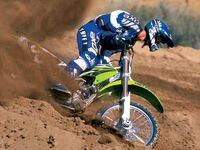
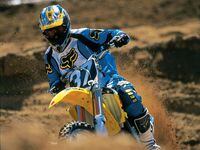
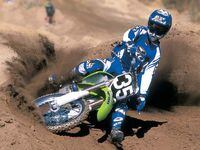
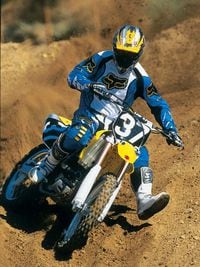
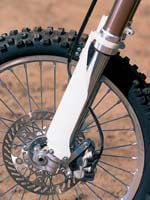
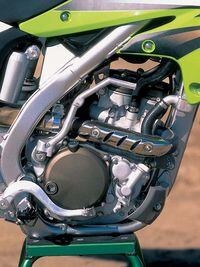
/cloudfront-us-east-1.images.arcpublishing.com/octane/MMROGOYHXZAYDC4RKIDJ4VRSGA.jpg)
/cloudfront-us-east-1.images.arcpublishing.com/octane/FHRWLPEOTBFOHFTQLIHJNIXCFQ.jpg)
/cloudfront-us-east-1.images.arcpublishing.com/octane/J2RUDOXTOZHBXOFCUQKBAGBMAQ.jpg)
/cloudfront-us-east-1.images.arcpublishing.com/octane/UDQASRGJ3ZDG3BANXWU6P5NIQY.jpg)
/cloudfront-us-east-1.images.arcpublishing.com/octane/YIICVWCT7FDURLJQ2H4AIMXLOY.jpg)
/cloudfront-us-east-1.images.arcpublishing.com/octane/SKYGGQY3XJCPDAM4CUHUXBS444.jpg)
/cloudfront-us-east-1.images.arcpublishing.com/octane/AONOEIBHJBGMBOCD5HBWVB3UAI.jpg)
/cloudfront-us-east-1.images.arcpublishing.com/octane/76O4I66VBNBS5GXX4DNHXXKHR4.jpg)
/cloudfront-us-east-1.images.arcpublishing.com/octane/3LSXOLSH3NEJDBMO3JZ6CYMK5M.jpg)
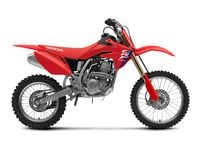
/cloudfront-us-east-1.images.arcpublishing.com/octane/QNIQ2A4UEBGNRKB4STEBJPMUX4.jpg)
/cloudfront-us-east-1.images.arcpublishing.com/octane/35SLCX4NQ5AFTHU6EY7FJSNGEY.jpg)
/cloudfront-us-east-1.images.arcpublishing.com/octane/LVH6MQASTRA2RJ74WY2PM7OAFI.jpg)
/cloudfront-us-east-1.images.arcpublishing.com/octane/TDBZ2JZJ7ZBNBLMB677WNPFLJE.jpg)
/cloudfront-us-east-1.images.arcpublishing.com/octane/3JLESTQC3RFDNBJBXT4OMYU65Q.jpg)
/cloudfront-us-east-1.images.arcpublishing.com/octane/4OOTARNHZRFEJJ5ZPVQMG3H6FE.jpg)
/cloudfront-us-east-1.images.arcpublishing.com/octane/MF32EN5WZNAEXCNYDYFNKMC2AE.jpg)
/cloudfront-us-east-1.images.arcpublishing.com/octane/UGLO3U37HJHGLM22F3D4XOWNVE.jpg)
/cloudfront-us-east-1.images.arcpublishing.com/octane/WSK35AT3LBBH7GZSXAXXREGF6U.jpg)
/cloudfront-us-east-1.images.arcpublishing.com/octane/OXEZZUYKDJHFVB4K7AIQSLRR7M.jpg)
/cloudfront-us-east-1.images.arcpublishing.com/octane/RVOG445TMRAZBNJ77OV3TN5QGQ.jpg)
/cloudfront-us-east-1.images.arcpublishing.com/octane/IQNDTQPP4BE3HE5JUWJ36ONAUU.jpg)
/cloudfront-us-east-1.images.arcpublishing.com/octane/Z6YUC3S26FF4TOKFTXZ7I746YY.jpg)
/cloudfront-us-east-1.images.arcpublishing.com/octane/UOWIK3H4BJHP7F4ONETCB7IXDQ.jpg)